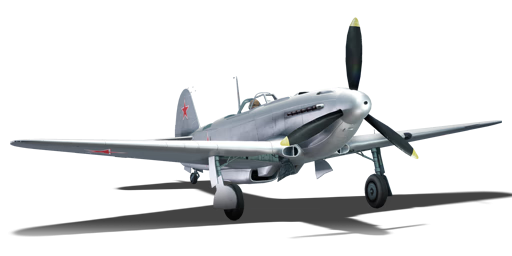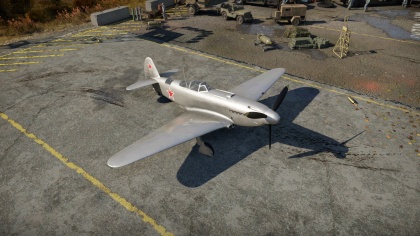Yak-9P
Contents
| This page is about the Russian fighter Yak-9P. For other uses, see Yak-9 (Family). |
Description
The Yak-9P is a rank IV Soviet fighter
with a battle rating of 5.0 (AB/RB) and 5.3 (SB). It was introduced in Update 1.31.
General info
Flight Performance
Describe how the aircraft behaves in the air. Speed, manoeuvrability, acceleration and allowable loads - these are the most important characteristics of the vehicle.
| Characteristics | |||||||
|---|---|---|---|---|---|---|---|
| Stock | |||||||
| Max Speed (km/h at 5,000 m) |
Max altitude (meters) |
Turn time (seconds) |
Rate of climb (meters/second) |
Take-off run (meters) | |||
| AB | RB | AB | RB | AB | RB | ||
| 638 | 620 | 10,500 | 22.7 | 23.0 | 15.1 | 15.1 | 540 |
| Upgraded | |||||||
| Max Speed (km/h at ?,000 m) |
Max altitude (meters) |
Turn time (seconds) |
Rate of climb (meters/second) |
Take-off run (meters) | |||
| AB | RB | AB | RB | AB | RB | ||
| ? | ? | 10500 | ??.? | ??.? | ??.? | ??.? | 540 |
Details
| Features | ||||
|---|---|---|---|---|
| Combat flap | Take-off flap | Landing flap | Air brakes | Arrestor gear |
| X | X | ✓ | X | X |
| Limits | ||||
|---|---|---|---|---|
| Wing-break speed (km/h) |
Gear limit (km/h) |
Combat flap (km/h) |
Max Static G | |
| + | - | |||
| 410 | ~20 | ~15 | ||
| Optimal velocities | |||
|---|---|---|---|
| Ailerons (km/h) |
Rudder (km/h) |
Elevators (km/h) |
Radiator (km/h) |
| < 380 | < 420 | < 490 | > 270 |
| Compressor (RB/SB) | ||
|---|---|---|
| Setting 1 | ||
| Optimal altitude | 100% Engine power | WEP Engine power |
| 2,000 m | 1,590 hp | 1,670 hp |
| Setting 2 | ||
| Optimal altitude | 100% Engine power | WEP Engine power |
| 4,300 m | 1,510 hp | 1,530 hp |
Survivability and armour
- 8 mm Steel - Plate behind pilot's seat
- 64 mm Bulletproof glass - Pilot's head rest
- 64 mm Bulletproof glass - Front canopy window
Armaments
Offensive armament
The Yak-9P is armed with:
- A choice between three different cannons, the 20 mm B-20M, 23 mm NS-23, or the 37 mm N-37:
- 1 x 20 mm B-20M cannon, nose-mounted (115 rpg)
- 1 x 23 mm NS-23 cannon, nose-mounted (75 rpg)
- 1 x 37 mm N-37 cannon, nose-mounted (28 rpg)
- 2 x 20 mm B-20S cannon, nose-mounted (120 rpg = 240 total)
Usage in battles
When stock, the Yak-9P will be pretty similar to the Yak-3P. Three 20 mm cannons which are good taking down fighters and heavy fighters, but its still quite hard to kill big targets such like B-17. When unlocking the 23 mm cannon, the damage is higher, but it carries significantly less ammo than the 20 mm. However, when equipping the 37 mm cannon, the effectiveness of the fighter increases significantly, having weaponry close to MiG-9 or MiG-15. The 37 mm cannon has an excellent rate of fire, won't jam easily, has great accuracy and carries a good amount of ammo. A single hit can kill a fighter or heavily damage it, and big bombers like B-17s will be killed with one or two hits on a wing.
The Yak-9P is best when used in turn fights and boom and zoom attacks, but speeds of 700 km/h or higher can end on low control response (making it hard to recover) and wings breaking. It can climbs best at 20 degrees and 10-15 above 4000 m. It has great engine performance and will sightly overheat after long WEP use, but will cool down quickly when reducing to just 85-90% throttle.
One rather unique feature of the Yak-9P is the modification possibility for ones own liking. The default setup is has got a centerline B-20M. It is virtually the same as the B-20S and utilizes the same belts OR one can switch out the 20 mm for a nasty 23 mm. The suggested modification by many pilots. The NS-23 has similar ballistics to the installed 20 mm cannons but packs more punch. Fortunately the rate of fire is lower for the NS-23 and both arms will run out of ammunition at roughly the same time. For the fellow pilots who still dreams of the Yak-9T: The 37 mm "howitzer", it is a deceptive package though! The N-37 is not the NS-37 from the Yak-9T and lacks any decent anti-armour shells, losing 20 mm of penetration. Two shells were also lost from the 9T, but on the bright side it still delivers painful HE warheads to the enemy.
Manual Engine Control
| MEC elements | ||||||
|---|---|---|---|---|---|---|
| Mixer | Pitch | Radiator | Supercharger | Turbocharger | ||
| Oil | Water | Type | ||||
| Controllable | Not controllable | Not controllable | Not controllable | Separate | Not controllable | Not controllable |
Modules
| Tier | Flight performance | Survivability | Weaponry | |||
|---|---|---|---|---|---|---|
| I | Fuselage Repair | Radiator | Offensive 20 mm | New 20 mm Cannons | ||
| II | Compressor | Airframe | Offensive 23 mm | NS-23 Cannon | ||
| III | Wing Repair | Engine | New 23 mm Cannons | |||
| IV | Engine Injection | Cover | Offensive 37 mm | N-37 Cannon | New 37 mm Cannons | |
Four upgrades are of importance: Offensive 20 mm, Compressor, Engine and Engine Injection. During this grind the second weapons profile (NS-23) can be easily be obtained without wasting time or XP.
Pros and cons
Pros:
- Very fast
- Powerful armament
- Good energy retention, vertical & horizontal
- Decent rate of climb
Cons:
- Can't reach speeds as high as other aircraft during dives (such like F7F, F8F, P-51)
- Not very nimble at speeds lower than 300 km/h
- Very high repair costs
History
The Yak-9 was a Soviet single-engine fighter of the WWII era. It was the first combat aircraft designed by Alexander Yakovlev's construction bureau. The most mass-produced Soviet fighter of the war, it remained in production from October 1942 to December 1948, with a total of 16,769 built.
The Yak-9 was a further modification of the Yak-1 and Yak-7. In its core design, it was a redesign of the Yak-7. With few external differences, Yak-9 was at the same time much more advanced internally. This is not unexpected, as almost two years of design and combat experience of the Yak series went into the Yak-9. Also, at the time aluminium was in much greater supply than it had been two years previously at the start of the war. Amongst other things, the use of metal allowed the plane’s weight to be significantly reduced, meaning that more fuel could be stored and that the aircraft could be equipped with more powerful armament and more specialized equipment.
Media
Excellent additions to the article would be video guides, screenshots from the game, and photos.
See also
Links to the articles on the War Thunder Wiki that you think will be useful for the reader, for example:
- reference to the series of the aircraft;
- links to approximate analogues of other nations and research trees.
External links
Paste links to sources and external resources, such as:
- topic on the official game forum;
- encyclopedia page on the aircraft;
- other literature.
| USSR fighters | |
|---|---|
| I-15 | I-15 WR · I-15 M-22 · I-15 M-25 · I-15bis · Krasnolutsky's I-15bis |
| I-153 M-62 · Zhukovsky's I-153-M62 · I-153P | |
| I-16 | I-16 type 5 · I-16 type 10 · I-16 type 18 · I-16 type 24 · I-16 type 27 · I-16 type 28 · I-180S |
| I-29 | I-29 |
| I-185 | I-185 (M-71) · I-185 (M-82) |
| I-225 | I-225 |
| ITP | ITP (M-1) |
| MiG-3 | MiG-3-15 · MiG-3-15 (BK) · MiG-3-34 |
| LaGG | I-301 · LaGG-3-4 · LaGG-3-8 · LaGG-3-11 · LaGG-3-23 · LaGG-3-34 · LaGG-3-35 · LaGG-3-66 |
| La | La-5 · La-5F · La-5FN · La-7 · Dolgushin's La-7 · La-7B-20 · La-9 · La-11 |
| Yak-1/7 | Yak-1 · Yak-1B · Yak-7B |
| Yak-3 | Yak-3 · Eremin's Yak-3(e) · Yak-3P · Yak-3T · Yak-3U · Yak-3 (VK-107) |
| Yak-9 | Yak-9 · Yak-9B · Golovachev's Yak-9M · Yak-9T · Yak-9K · Yak-9U · Yak-9UT · Yak-9P |
| Other countries | ▂P-40E-1 · ▂P-47D-27 · ▂Hurricane Mk IIB · ▂Fw 190 D-9 · ▂Spitfire Mk IXc |
| P-39 | ▂P-39K-1 · ▂Pokryshkin's P-39N-0 · ▂P-39Q-15 |
| P-63 | ▂P-63A-5 · ▂P-63A-10 · ▂P-63C-5 |





